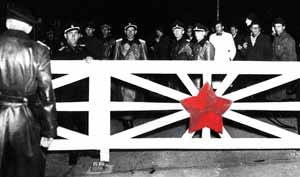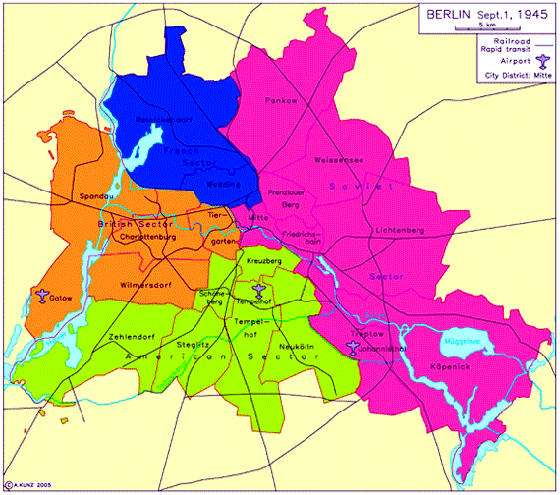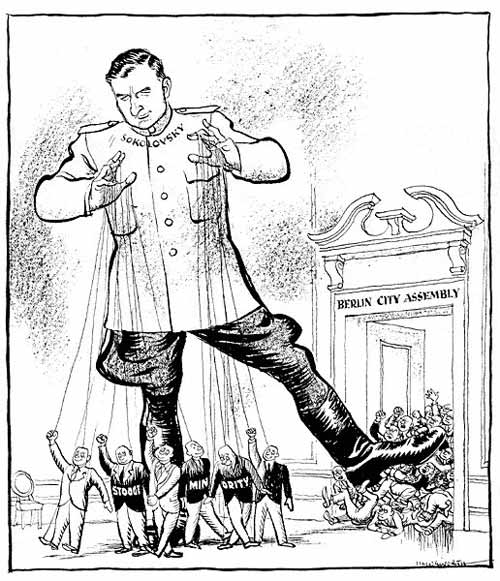A Tale of Two Cities
A Divided Berlin
Against the backdrop of increasing tensions between the East and West the United States and Great Britain called together a six nation conference to meet in London in February 1948 to decide the future of Germany. Beside the Americans and British, other attending nations would be France, and the Benelux (Belgium, Netherlands, and Luxembourg). The Soviets did not attend. Frustrated at the failure of the four orginal governing powers to reach an accord, the Americans and British sought an independent solution that among other issues would address the flagging German economy and consider the establishment of an independent West Germany. As part of this initiative the western Allies also planned to introduce new currency in their zones to replace the greatly devalued Reich Mark (RM). This new Deutsch Mark (DM) would be exchanged for the old money over time. Incensed over this proposal the Soviets withdrew from the Allied Control Council (ACC) the joint governing body of the occupied zones and moved to take drastic actions. In a prepared statement released in June 1948 at the conclusion of the London Conference Marshal Vassili Sokolovsky, Commander-in-Chief of the Soviet Military Administration of Germany announced:
The Soviets refused to permit the use of the new currency in Berlin. A divided Germany and a divided city waited anxiously for the next step.Pursuing a policy of splitting Germany, the American, British, and French monoplies are relying, in the Western German zones of occupation, on the representatives of big German capital and Junkerdom, who brought fascism to power and prepared and launched the Second World War. The separatist currency reform strengths the political and economic position of these reactionary circles, to the detriment of the interests of the working people.1
A Stalinist Lens
Sokolovsky's message reflected the thoughts of Soviet leader Joseph Stalin who saw beyond the currency polemics and considered the totality of a greater evolving East-West conflict. In this context Stalin's real concern was for the emergence of an economically viable West Germany that would fall under the shadow of American control and eliminate any potential opportunity for Soviet influence in either the western zones or western Berlin. He saw the world in terms of competing hegemonies, one in the East controlled by the Soviets and one in the West by the United States.
Opening Gambit

The Soviets moved to quickly block all surface routes connecting West Berlin. Image Source: German Historical Institute.
On 19 June 1948 Soviet border guards were given instructions to to halt all passenger traffic on the autobahn to Berlin and all passenger trains. Additionally they delayed all freight shipments from the Allied West and announced that all water transport, primarily barge traffic, would require special permission to proceed. Against protests from the West the Soviets increased the pressure. On 22 June they announced the release of a separate currency to be called the 'Ostmark' for circulation in the East German Zone and Berlin. Two days later the Soviet military severed all land and water communication between the non-Soviet western zones and Berlin and stopped all rail and water traffic entering or leaving the city. Within twenty-four hours they halted all deliveries of food and cut off all electricity that was supplied by generation plants in the Soviet-controlled zone. Estimates were that the Allies in Berlin had approximately thirty-five days supply of food and forty-five days supply of coal. The blockade had begun.
Hard Times
The people of Berlin immediately felt the effects of the blockade. One diarist noted, "The prices go up every hour. One pound of coffee, two thousand marks. One cigarette, thirty marks. You are lucky to find one at all."2 Closed in on all sides a great dread hung in the air. The Berliners understood that the Americans were considering evacuating their military dependents by air. The United States had only 3,000 troops in the city. The British and French 3,500 combined. The Soviets had 18,000 military personnel in east Berlin and 300,000 in their entire zone. The situation appeared desperate. Would the Soviets threaten military action? Would the Western Allies abandon the city?






